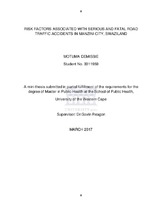| dc.description.abstract | Background: Road Traffic Accidents (RTAs) are an important cause of morbidity and mortality worldwide, especially in low and middle-income countries. Traffic police reports indicate that RTAs are amongst the commonest health challenges Swaziland faces. Assessing the magnitude of the challenge, understanding the impact on public health and gaining more insight into the actual risk factors involved in RTAs, and especially RTAs that result in serious injuries and fatalities, is important for the road transport authority, the traffic police and for public health planners, in order to improve road safety, to develop effective countermeasures and to improve preparedness for effective health care, respectively. There is an insufficiency of studies on risk factors associated with RTAs, and particularly those associated with serious and fatal RTAs, in Sub-Saharan countries in general and Swaziland
specifically. Manzini, a busy small city in Swaziland with a population of 61000 and an estimate of approximately 12000 vehicles on its roads daily is the setting for this study. RTAs in Manzini, are considered as a major public health problem with many people either seriously injured or killed on the roads annually. Aim: The aim of this study was to determine the human (e.g. age, gender, speeding and drunk driving), vehicle (e.g. vehicle types and vehicle defects), infrastructural (e.g. type of roads, road surface defects and road lighting) and environmental risk factors (e.g. rain and darkness) associated with serious and fatal RTAs in Manzini city and surrounding suburbs in Swaziland. Methodology: A case control study, based on data collected from RTA records at Manzini Traffic Police Station, was conducted. The study population was all RTAs in Manzini, with cases being RTAs that resulted in serious or fatal injuries, while RTAs with no injuries (vehicle and property damage only) and minor injuries were categorised as controls. A sample size of 294 consisting of all 143 RTAs with fatal and serious injury that occurred from July 2013 to June 2015 in Manzini city as cases and a random sample of 151 controls from amongst the minor injury and property damage only RTAs, was selected. A standardised data extraction tool was used to collect data from routine traffic police records on all RTAs. Frequencies were calculated for categorical variables. Numerical variables were summarised mathematically, via their central tendencies and distribution as well as collapsed into meaningful categories. Bivariate analysis to ascertain odds ratios was undertaken and all risk factors that showed a significant association with severe and fatal RTAs were further assessed via multivariate logistic regression analysis. Ethical approval for the study was secured from the Swaziland National Ethics Committee and the University of the Western Cape Research and Ethics committee. Results: Factors that had an unconfounded association on multivariate analysis with serious/fatal RTAs, compared to minor RTAs, were: male drivers (AOR = 5.48; 95% CI = 1.63 – 18.43); drivers not wearing a seatbelt (AOR = 5.07; 95% CI = 2.39 – 10.74); pedestrian error (AOR = 2.66; 95% CI = 1.46 – 4.86); accidents occurring on weekends (AOR 3.62; 95% CI = 2.07- 6.33); and accidents occurring between 18:00 – 23:59 time of the day (AOR = 11.68; 95% CI = 4.49 - 30.39). Other factors such as: age of driver, no driver's license at the accident scene, drunk-driving, seasons of the year, driver error, vehicle type, vehicle defect, road surface type, road surface condition, weather condition, street light condition and urban/rural location were not found to be associated with serious/fatal RTAs in our study. Limitations Limitations of the study were that some data collected at the scene of the accident were incomplete and not collected in a standardised manner (alcohol use, speeding, vehicle defects, road defects and environmental factors) and that there was probable misclassification of some serious/fatal RTAs as minor ones and under-reporting of minor RTAs. Also several variables which may affect the severity of RTAs, such as educational level, socioeconomic status, medical illness, marital status and emotional status of the driver, were not routinely collected by the traffic police department and hence were not assessed. Conclusions and Recommendations: Modifiable risk factors that had an unconfounded positive association with serious/fatal RTAs were not using a seatbelt, night-time driving, weekend driving and pedestrian error, while male gender might be a proxy for reckless driving. Hence, education programmes for drivers and the public on behavioural change encouragement, improving pedestrians' road safety by provision of pedestrian sidewalks and crossing sites, coupled with increased traffic law enforcement at critical days and times, may result in reduction of serious/fatal RTAs. | en_US |

